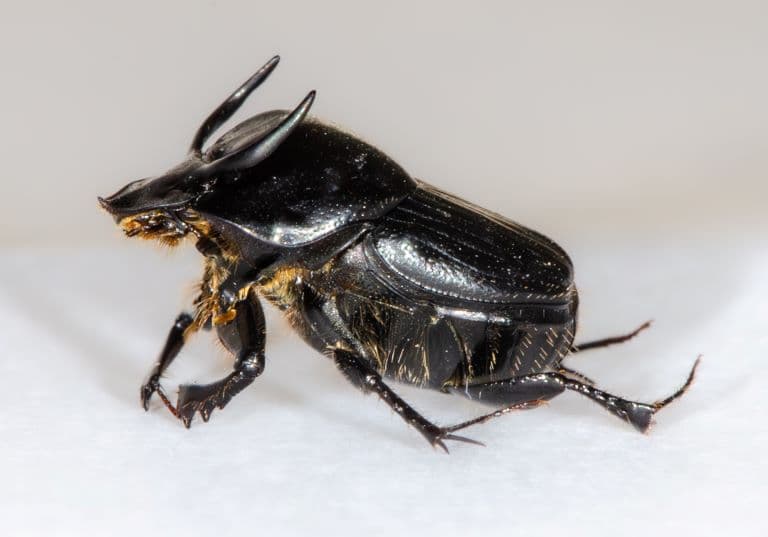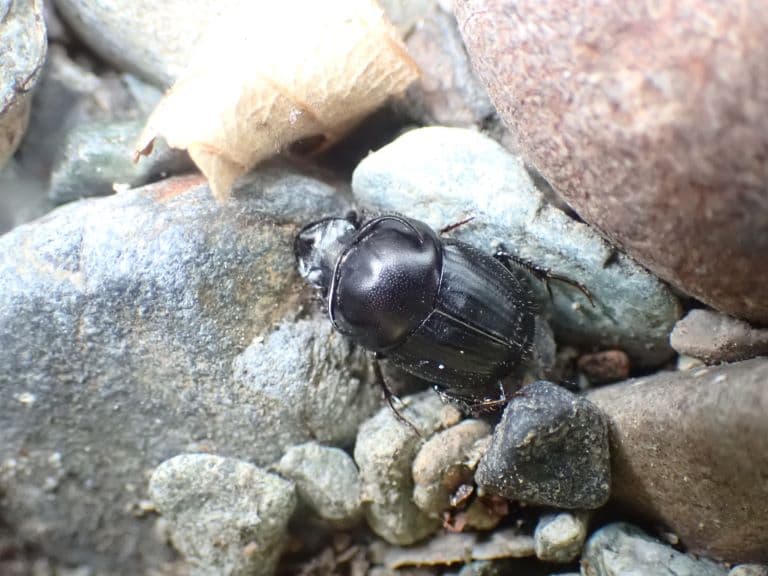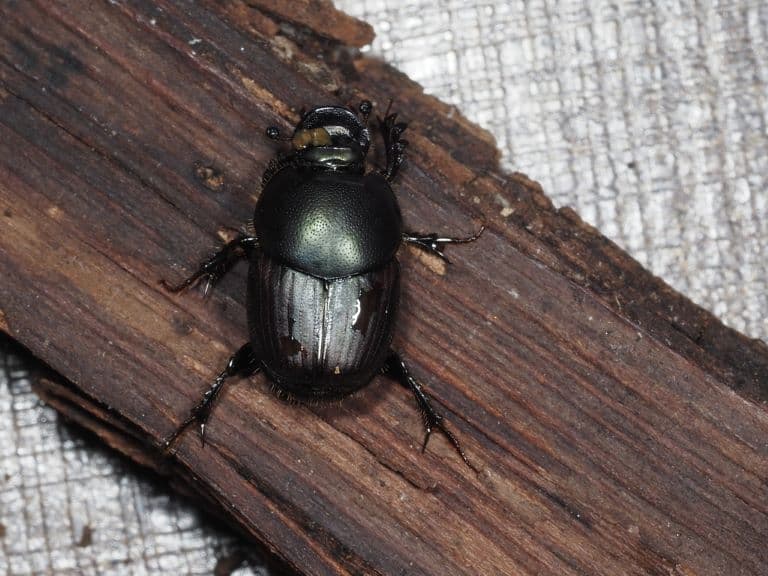Taurus Scarab Profile
As we all know from the primitive mystical nonsense of late Mesopotamia, Taurus is an Earth sign represented by the bull, and being controlled by Venus, the most sensual of all the arbitrary symbols.
As we know from Ancient Egyptian mythology, Scarabs represent life, death, and rebirth.
It makes perfect sense, then, that Taurus scarabs are horny little bull-like beetles that recycle poo.

Taurus Scarab Facts Overview
| Habitat: | Varied, anywhere with herbivore poop |
| Location: | Australia, Europe, North Africa, Asia, USA (Texas) |
| Lifespan: | Unknown |
| Size: | 5.5–11 millimetres (0.22–0.43 in) |
| Weight: | Unknown |
| Colour: | Usually black or reddish brown |
| Diet: | Poop |
| Predators: | Birds, mammals, lizards |
| Top Speed: | Slow |
| No. of Species: | 1 |
| Conservation Status: | Not Listed |
Few beetles are as useful or as reliable as scarabs, and the Taurus beetle is a perfect example of why. This hugely successful nutrient recycler has some unique, sexually-selected characteristics.
They’re incredibly strong, horny and have gargantuan balls. Of course, this is all relative, and shouldn’t be used as a basis of comparison for larger animals…
Interesting Taurus Scarab Facts
1. They’re so useful!
While the Babylonians were way off with their idea of star signs and personality traits, the Egyptians were more astute.
Scarab beetles are some of the most important animals on Earth, and not only for lucky charms.
Many scarabs, like the Taurus scarab, are dung beetles, and they play a critical role in transforming what comes out of an animal into what goes into a plant.
Scarabs are so good at this that they occupy the poo-recycling niche on every continent except Antarctica. 1
2. They’re very successful
Few occupations have as much job security as a qualified poop recycler. And the Taurus scarab has exploited this niche to impressive success.
This single species of dung beetle is found rolling faeces all over Europe, the US, North Africa, Asia, the Middle East and New Zealand.
In New Zealand, they were deliberately Released to improve grazing space for cattle, reduce fly and bacteria habitats, and decrease the need for chemical fertilizers.

3. They’re horny
The characteristic horns on the front end of this species are considered an evolutionary novelty.
These horns are mostly for show, but also may help in winning the wrestling matches this species engage in to access breeding tunnels.
While there’s still quite a bit to understand about these appendages, they’re already throwing up some fascinating genetic discoveries, and demonstrating the complex and powerful role of sexual selection in this species.
4. They’re part hedgehog
This is a bit convoluted and contrived, but here goes. The hedgehog gene is named after the irreplaceable fruit fly, Drosophila, inside which it was first discovered.
Geneticists noticed that fruit fly embryos with mutations on this gene produced spikes, and so named it after the most famous spiky animal there is. It’s a gene responsible for the growth of various structures in an animal’s development.
Taurus beetles have this gene, and it’s thought to be responsible for the horn-like protrusions that are so common in males of the species.
Hedgehogs also have this gene, as do all mammals and most vertebrates (who even have one class of the gene called the Sonic hedgehog gene), but in these little beetles, they play an understated role in sexual selection. 2
5. The horns are indicative of their diet
In the animal kingdom, exaggerated secondary sexual characteristics do a lot more than just fill the Victoria’s Secret window in the mall, they’re often a visible representation of the nutritional history of their host.
Some of the genes responsible for the horns on beetles are only activated in the presence of optimal nutrition, essentially showing any potential mates that the inside of this beetle has been well looked after and therefore that this individual should be a good candidate for passing on their genes.
The horns are therefore walking billboards of reproductive fitness, but not all Taurus beetles have them, and those who don’t, need to come up with other solutions.

6. Smaller horns, bigger knackers
Not all males have these horns. Smaller males typically don’t, and it’s hypothesized that at some stage of their development, resource allocation was moved away from the development of obnoxious displays of virility and toward epic testicles.
It seems that smaller males have significantly larger testes than males with horns, which is a clever way of compensating and is essentially the beetle equivalent of being a grower, not a shower. 3
7. They can pull
A beetle with this amount of raw gonadal sway has no trouble pulling, and quite literally, these are some of the most impressive beetles in the field.
It’s said that a Taurus beetle can pull up to 1141 times its own body mass. This is the strongest “pound-for-pound” animal on record and another proud accolade for the amazing beetle order.
The origin paper for this factoid appears to have been removed from the internet and none of the correspondents reporting it thought to mention the relevant information, so just how much the beetle weighs, and consequently, can pull, remains a bit of a mystery.
And as tempting as it then becomes to make inane equivalencies with humans pulling six busses and the like, these would ignore some key physical principles and the non-linear scalability of biomechanics, physiology, leverage, gravity and other size-related factors.
So don’t do it.
8. This is also the product of sexual selection
Beetles are notoriously strong, and in at least this instance, the Taurus beetle’s strength is another example of their sexually-selected characteristics.
Male beetles fight for reproductive rights by pushing and shoving one another, and this form of evolution is so fast and powerful that even in experiments where the traits were genetically damaged by unhinged geneticists, female Taurus beetles were able to undo the damage within two generations. 4
9. Climate change might help them
At least, where this species has been introduced, there’s growing evidence that the changing climate may not affect them as much as their native counterparts.
This sounds like a good thing, at first, but it’s essentially a form of invasiveness that will be exacerbated by the impending climate catastrophe, giving the introduced species a boost in fitness over their native counterparts that may ultimately cause localized extinctions. 5
Taurus Scarab Fact-File Summary
Scientific Classification
| Kingdom: | Animalia |
| Phylum: | Arthropoda |
| Class: | Insecta |
| Order: | Coleoptera |
| Family: | Scarabaeidae |
| Genus: | Onthophagus |
| Species: | taurus |
Fact Sources & References
- “ARTICLE Dung beetles released on farms”, Science Learning Hub.
- Teiya Kijimoto (2016), “Hedgehog signaling enables nutrition-responsive inhibition of an alternative morph in a polyphenic beetle”, PubMed Central.
- Teiya Kijimoto (2013), “Beetle horns and horned beetles: emerging models in developmental evolution and ecology”, NIH.
- Maria Almbro (2013), “SEXUAL SELECTION CAN REMOVE AN EXPERIMENTALLY INDUCED MUTATION LOAD”, JSTOR.
- Margaret A. Mamantov (2020), “Behavioural responses to warming differentially impact survival in introduced and native dung beetles”, British Ecological Society.
